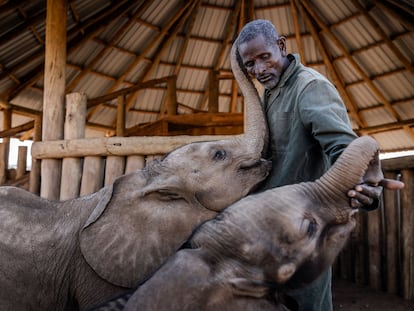Elephants address one another with name-like calls
New research has shown that the species use individual vocalizations to call specific members of the herd, which go beyond mere imitations of the addressee

Elephants don’t just trumpet. That sharp sound, like that of a trumpet, could be compared to a human’s cry to alert or warn others. But elephants also emit a range of low-frequency harmonic sounds, such as murmurs, that are specific to each animal. Now, assisted by an artificial intelligence system, a group of researchers has demonstrated that elephants use specific sounds to call each member, as if they were calling them by name.
Since 1986, scientists from Colorado State University, two foundations and the Amboseli Elephant Research Project (Kenya) have been recording several herds of Savannah elephants in three national parks and reserves. Over the years, they have collected thousands of hours of recordings for the Elephants Voices project. With these recordings, they were able to differentiate between various sounds. For example, a mother’s call to her calf does not happen while she is in sight or is less than 50 meters away. They are contact calls. These murmurs also occur as a kind of greeting, when two members of the same herd meet, and cease when physical contact is made. A third call is the one mothers use to comfort, nurse, or wake their young.
But Michael Pardo, a U.S. National Science Foundation graduate student at the University of Colorado, was convinced that more could be discovered from the collection of recordings. As Pardo and his research colleagues detail in the scientific journal Nature Ecology & Evolution, they designed a machine learning system that could compare, analyze and break down calls made by 101 African elephants into their basic acoustic properties.
This artificial intelligence (AI) program was able to identify the receiver in 27.5% of the calls issued by the elephants. A successful identification in just a third of the cases may not seem like much, but Pardo believes the opposite is true: “It is not surprising that the model was only able to identify the receiver in 27.5% of the calls. , because we wouldn’t expect elephants to use names in every call they make.” The researcher gives the example of humans and bottlenose dolphins, which also have a system for calling each other and “only use names in a small percentage of their expressions, so the same probably happens with elephants.” Since they did not know in advance which calls contained a name when they started the model, they had to use all the elephant calls. “It is therefore not surprising that the model only correctly identified the receiver in a fraction of the calls,” he says.
To confirm the AI system’s findings, the researchers conducted a series of field experiments. In these, they played back several of the calls in the vicinity of their intended recipients and, as a control group, near other elephants. Unmistakably, the animals to which a call was not directed continued as normal. But in almost all cases where the listener was the recipient identified by the system, the elephant paid attention, raised its head and, almost always, responded to the call and ended up heading toward the speaker.
The researchers also wanted to answer one last question, the one that would definitively show if elephants call the other members of the herd by name. The AI system grouped all the calls made by different animals to the same recipient. While the calls were not identical (humans don’t say “Mary” the same way either), the scientists did observe that the acoustic properties of the different calls were more similar to each other than to the other calls to different recipients.
Pardo recognizes that this is not conclusive evidence. “On the one hand, calls from different individuals calling the same receiver were more similar on average than calls from different animals calling different receivers, suggesting that they call using the same (or at least similar) name,” he explains. “But, on the other hand, when we tried to train the machine learning model to identify patterns in calls that were for individual receivers regardless of who was calling you (i.e., identify a common name that several used to address the same receiver), it was unable to do so,” he adds.
The common or proper name is key. By definition, naming something is an innate skill, which has to be learned. Many social species have it. Several arboreal primates emit a different alarm sounds depending on if the predator they have detected is coming from the sky, in the case of an eagle, or climbing up the tree, if it is a leopard. But naming in a specific, concrete way is rarer. Very few animals (such as bottlenose dolphins and several species of parrots and parakeets) use a specific call to attract the attention of another member of the group. But what they are doing is imitating how that member speaks in order to grab its attention.
Bruno Díaz, the scientific director of the Bottlenose Dolphin Research Institute (BDRI), knows a lot about communication between cetaceans. “Bottlenose dolphins have what we call a signature whistle. The characteristics of the whistle include information about each individual, as if it were a signature,” he explains. “In some cases, especially in pairs with strong social ties, mothers and calves or pairs of males, it has been observed that one specimen can copy the other’s signature whistle as a sign of the strong bond between them.”
But elephants are not imitating the call of the addressee. “They do not rely on imitation to address one another, which resembles the way human names work,” says Pardo.
Names, like almost all elements of human language excepting onomatopoeia, are arbitrary. There is nothing that relates a name to the subject that is being named. That provides great freedom, but requires cognitive skills.
“I think that the arbitrary nature of the calls gives us an idea of their cognitive abilities,” explains George Wittemyer, the scientific advisor of Save the Elephants and senior author of the study. “The ability to connect an arbitrary sound to an individual and for other members of a group to apparently recognize that arbitrary label suggests the ability to think abstractly and possibly symbolically.” But, he says: “I don’t think our study has shown that.” The researchers are now working on identifying the rest of the calls, looking for a meaning or intention.
Antonio J. Osuna, a researcher in animal cognition at the University of Veterinary Medicine in Vienna (Austria), who did not take part in the research, describes the findings as “fascinating.” Speaking to SMC Spain, he adds that very little is known about communication in other species and “this is due (among other reasons) to the fact that we are not sensitive to the multiple subtleties that the vocalizations of other species may contain. They simply escape our capabilities. That is why machine learning is becoming so important: it allows us to highlight differences and similarities that, otherwise, we would never be able to distinguish.”
Sign up for our weekly newsletter to get more English-language news coverage from EL PAÍS USA Edition
Tu suscripción se está usando en otro dispositivo
¿Quieres añadir otro usuario a tu suscripción?
Si continúas leyendo en este dispositivo, no se podrá leer en el otro.
FlechaTu suscripción se está usando en otro dispositivo y solo puedes acceder a EL PAÍS desde un dispositivo a la vez.
Si quieres compartir tu cuenta, cambia tu suscripción a la modalidad Premium, así podrás añadir otro usuario. Cada uno accederá con su propia cuenta de email, lo que os permitirá personalizar vuestra experiencia en EL PAÍS.
¿Tienes una suscripción de empresa? Accede aquí para contratar más cuentas.
En el caso de no saber quién está usando tu cuenta, te recomendamos cambiar tu contraseña aquí.
Si decides continuar compartiendo tu cuenta, este mensaje se mostrará en tu dispositivo y en el de la otra persona que está usando tu cuenta de forma indefinida, afectando a tu experiencia de lectura. Puedes consultar aquí los términos y condiciones de la suscripción digital.
More information
Archived In
Últimas noticias
Pablo Escobar’s hippos: A serious environmental problem, 40 years on
A floating school teaches children how to save Lake Atitlán
The brief rise and retreat of Generation Z in Mexico
From Andorra to Gibraltar, a black market for Ozempic exploits its success: ‘They’re the most sought-after products in the world’
Most viewed
- Why we lost the habit of sleeping in two segments and how that changed our sense of time
- Charles Dubouloz, mountaineering star, retires at 36 with a farewell tour inspired by Walter Bonatti
- Venezuela faces its most tense Christmas yet
- CBS in crisis after pulling a report on Trump’s deportations to El Salvador (which later leaked online)
- Bukele clan fumes over investigation exposing their new wealth











































